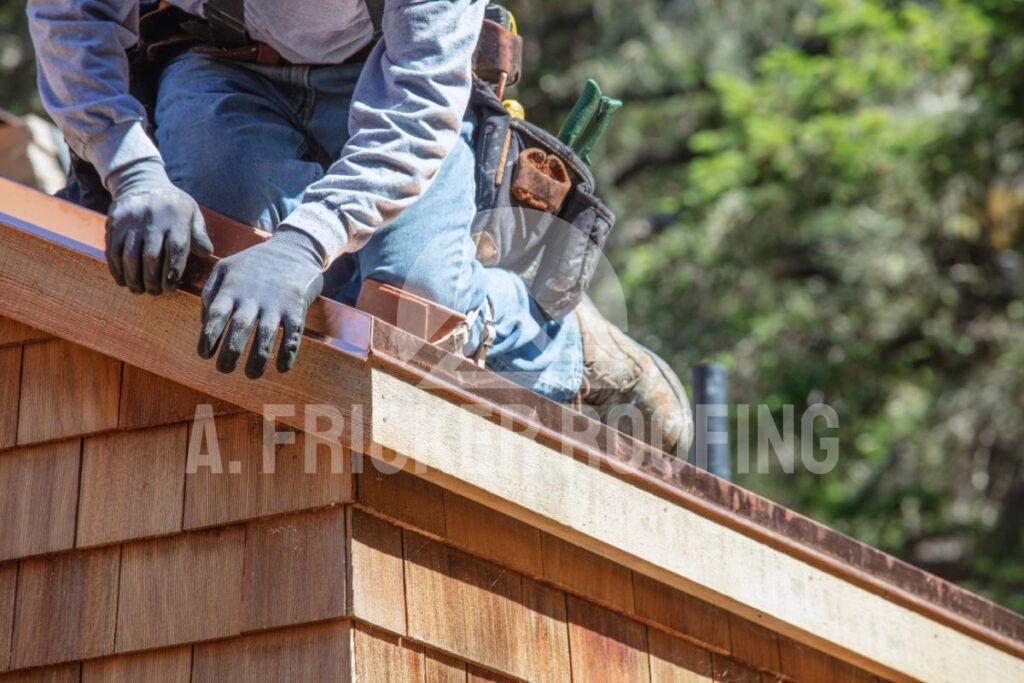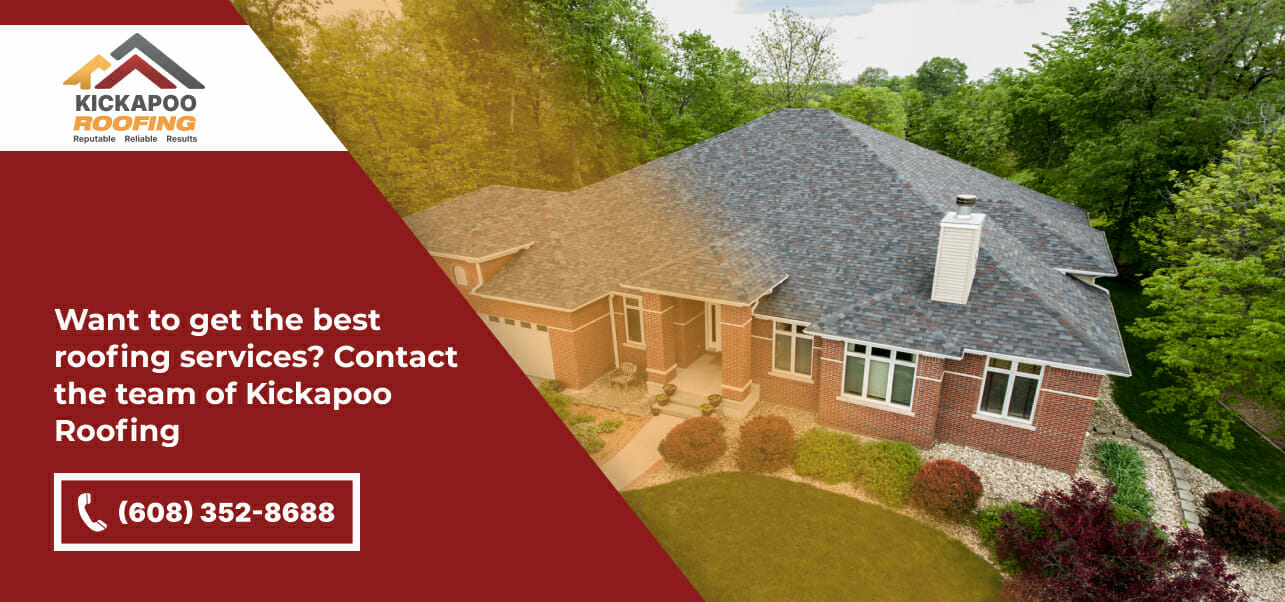Even the smallest parts of your roof are equally important for the overall performance of the roofing system. Today, in this article, we will be discussing an important part of your roof that not everyone may notice — the drip edge.
At Kickapoo Roofing, we are proud to be the leading roofing professionals in La Crosse, Wisconsin. To schedule a quality roof inspection for your property, feel free to call us today at (608) 352-8688.
What Is A Drip Edge?
Before getting into the different types, let’s start with what a drip edge actually is. A drip edge is a metal piece of flashing that is installed along the edges of your roof.
This L-shaped or T-shaped piece of metal performs the very important job of directing water away from your roof’s fascia and into your gutters.
Without a drip edge, water can easily slip beneath your shingles and damage your roof’s wooden components below. It also keeps your roof safe from wind-driven rain and prevents unwanted pests from entering through the roof edges.
What Are The Different Types Of Drip Edge?
Starting with what today’s article is all about, we will discuss different types of drip edge profiles and the common drip edge materials that you can find for your roofing needs.
Types of Drip Edge Profiles
Your drip edge can come in different shapes, better known as profiles, and each one has its own way of directing water away from your roof.
#1 Type C (L-Style)
This is perhaps the most simple and common type of drip edge. It looks just like the letter L, with a simple bend at a 90-degree angle. Type C drip edges work well for most homes and are very cost-effective.
#2 Type D (T-Style)
The T-style drip edge has a shape similar to the letter T. It extends further out over your gutters than the L-style, which makes it better at directing water away from your roof. Many roofing experts prefer this type for most homes.
#3 Type F (Extended Edge)
Type F drip edges have a longer edge that extends over your roof. This makes them very useful when you need to install a drip edge over existing shingles.
Types Of Drip Edge Materials
The material of your drip edge matters just as much as its shape. Here are the common materials you will find!
#1 Aluminum

Aluminum is perhaps the most popular choice for drip edges. It’s lightweight, doesn’t rust, and comes in many colors to match your roof. You can easily find aluminum drip edges that will last as long as your shingles.
#2 Galvanized Steel
Steel drip edges are stronger than aluminum ones. They work very well in areas with strong winds. The galvanized coating keeps them from rusting, making them a reliable choice for your roof.
#3 Copper

Copper drip edges are the most expensive option, but they offer a unique look that many homeowners love. Over time, copper develops a beautiful green color that adds character to your home.
Do Building Codes Require You To Have A Drip Edge?
Most local building codes today require you to have a drip edge on your roof. The International Residential Code also states that you must have drip edges on both the eaves and rake edges of a shingle roof.
When installing a drip edge, the rules say that each piece should overlap the next one by at least two inches.
The vertical part of your drip edge needs to extend at least a quarter-inch below your roof deck and go up the roof slope by at least two inches. These requirements help make sure your drip edge works properly to protect your home.
How to Choose the Right Type of Drip Edge for Your Roof
Choosing the right drip edge for your roof isn’t hard if you know what to look for.
Start by thinking about your local weather. If you live in an area with strong winds, a galvanized steel drip edge might be your best choice. For most homes, an aluminum drip edge works very well and costs less.
When it comes to the profile, Type D (T-style) drip edges often work best because they direct water further away from your fascia. But if you’re looking to save money, a Type C (L-style) drip edge can work just fine. For homes that already have shingles and need a new drip edge, Type F makes installation easier.
The color of your drip edge should also match your roof’s trim or fascia. Most aluminum drip edges are available in various colors, making them a nice choice.
If you want something beautiful and don’t mind spending more, copper drip edges can add a rustic and nice highlight to your home.
What Are The Common Signs That Your Drip Edge Needs Replacement?
Your drip edge might need replacement if you notice any of these problems:
#1 Water Stains on Your Fascia
If you see water marks or stains running down your fascia boards, your drip edge might not be doing its job properly. This means water is getting behind the drip edge instead of going into your gutters.
#2 Rotten Wooden Components
When you notice your fascia boards or roof deck starting to rot, especially near the edges, this could mean your drip edge isn’t protecting these areas from water damage.
#3 Visible Damage or Rust
Sometimes you can see obvious problems with your drip edge, like rust, bending, or gaps between pieces. These issues mean it’s time for a replacement.
Choose Your Trustworthy Local Roofers In Wisconsin
At Kickapoo Roofing, we are your local roofers who understand that each and every part of your roof needs careful attention during installation. That’s why we also aim to provide high-quality roofing services in Mayville and the surrounding areas in Wisconsin.
Our team offers the right level of experience and skills to handle all your roofing needs effectively. Whether it’s minor repairs or complete roof replacement, we assure you quality results against your investment.
We only use the best materials and follow proper installation techniques to ensure your roof performs well for years to come. We also take the time to explain your roofing options and help you make the best choices for your specific needs.
Our commitment to quality results and customer satisfaction has made us one of the most trusted roofing companies in Wisconsin. To schedule a roof inspection, or to get a free estimate, call us today at (608) 352-8688.
FAQs
A: A drip edge is a specific type of flashing that goes on your roof’s edges. Regular flashing is used around chimneys, vents, and other roof features where water might get in.
A: Yes, you can install a drip edge on an existing roof. Type F drip edges work especially well for this purpose, but it’s usually better to have a professional do this job.
A: A properly installed drip edge should last as long as your roof shingles, which is typically 20 to 30 years for most roofing materials.
A: The best type of drip edge depends on your specific needs, but Type D (T-style) in either aluminum or galvanized steel works well for most homes. Aluminum is popular because it’s affordable and doesn’t rust.
 (608) 352-8688
(608) 352-8688  schedule consultation
schedule consultation


